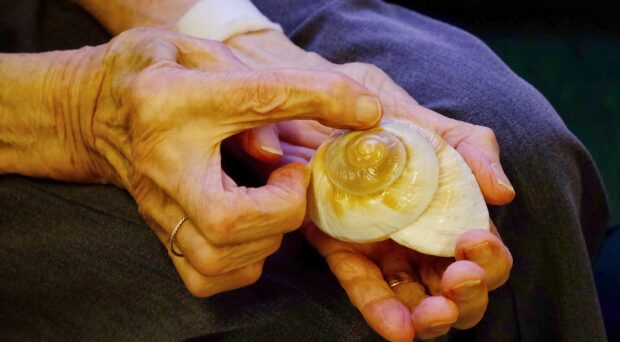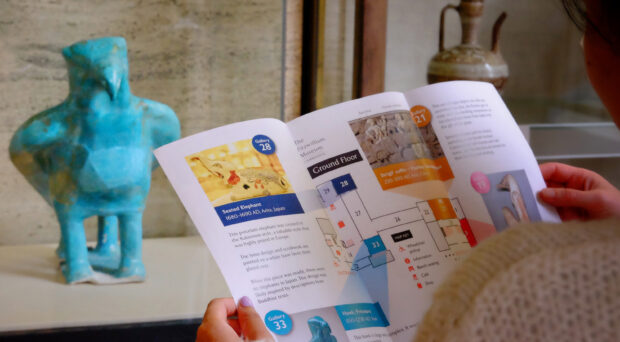Nathan Huxtable shares his experience here of developing and delivering a remotely delivered pilot art programme designed to engage the University of Cambridge Museums‘ (UCM) Portals to the World participants, people with a dementia diagnosis or cognitive impairment and their care partners. Nathan is the Fitzwilliam Museum’s Education Assistant and a practicing artist.
In its tenth year, Portals is a partnership programme delivered with Dementia Compass and combines regular courses with an Alumni programme. The regularity promotes familiarity, confidence and trust in the Museums. Each session comprises of a talk, gallery exploration and a creative or object handling activity. Portals emphasises ability over disability and provides opportunities for people to learn, share and create and to experience ‘respite together’.
A year of remote delivery
With effectively a year of lockdown passing we have been reflecting on our remote delivery and how we meet the needs of our various groups online. Having been closely involved with our Portals courses across the UCM it was clear the format was working well and the sessions running smoothly.
There were, however, requests for a live ‘make along’ session like those run in the Museum. We decided to offer this, not on the Thursday following the collection talk and discussion but given on the following day with the ambition of supporting people’s capacity for concentration on their making – at an enjoyable and hopefully successful pace.
Throughout the year we had been receiving emails from our participants sharing the art they had been creating inspired by the collection talks and the accompanying art activity/ making video and resources sent by post. This was such a treat and so inspiring to see what magic people were making together in their homes, it was, and is, a huge privilege to share such moments with people as part of our job. If I’m honest, although it is hard work in some respects, it never feels like work during the sessions. There are such mutual benefits for everyone involved.
The two collection talks, so far (February and March 2021) that have inspired these new live making sessions were Time for Tea, Museum of Archaeology and Anthropology, hosted by Sarah-Jane Harknett and The Human Touch, hosted by exhibition Curators Elenor Ling and Suzanne Reynolds, The Fitzwilliam Museum.
Pilot session 1: Time for Tea, the Museum of Archaeology and Anthropology (MAA)
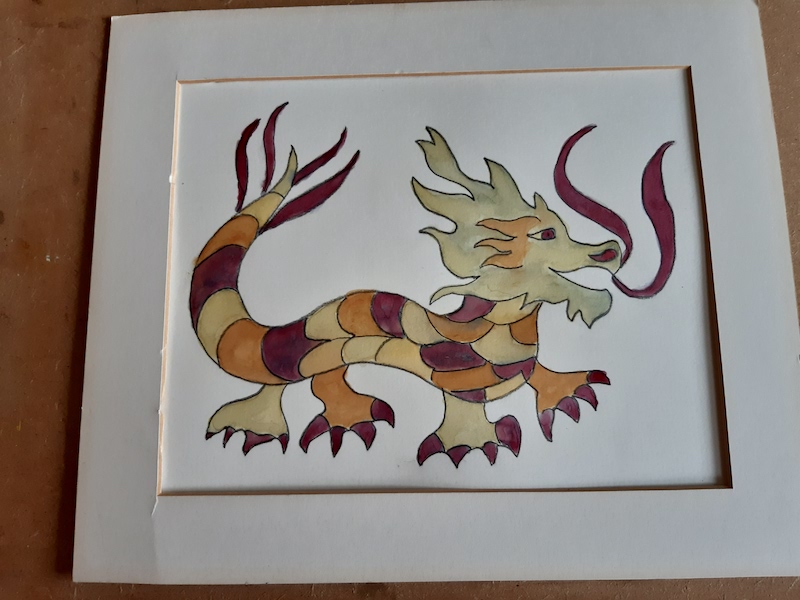
Other than water, tea is the most popular drink in the world. MAA has a surprising number of objects and photos about tea: from photos of tea houses to teapots and even the tea leaves themselves.
After some discussion we decided to use tea as our painting medium for the MAA making activity. We posted out watercolour paper, a variety of teas and printed images made from my drawings to work on. There were two activity sheets, one with tea leaves and a second dragon inspired image taken from a photograph of a block of tea with a dragon stamp imprinted on it. Tea companies used stamps to identify their product for export. There was also blank watercolour paper and various other papers to work on should they not wish to use the same images we provided. The opportunity to explore in your own way as well as having a staged option has always felt like an important part of the creative aspect of the Portals programme.
We sent teas that would hopefully have good contrasting colours, Breakfast tea, Lemon and Ginger, Orange and Turmeric and a berry tea. Once brewed, ready for the session, they all had differing strengths and hues. Breakfast tea was brown, lemon tea yellow, orange and turmeric an orangey brown hue and the berry tea a purple/blue shade when dry.
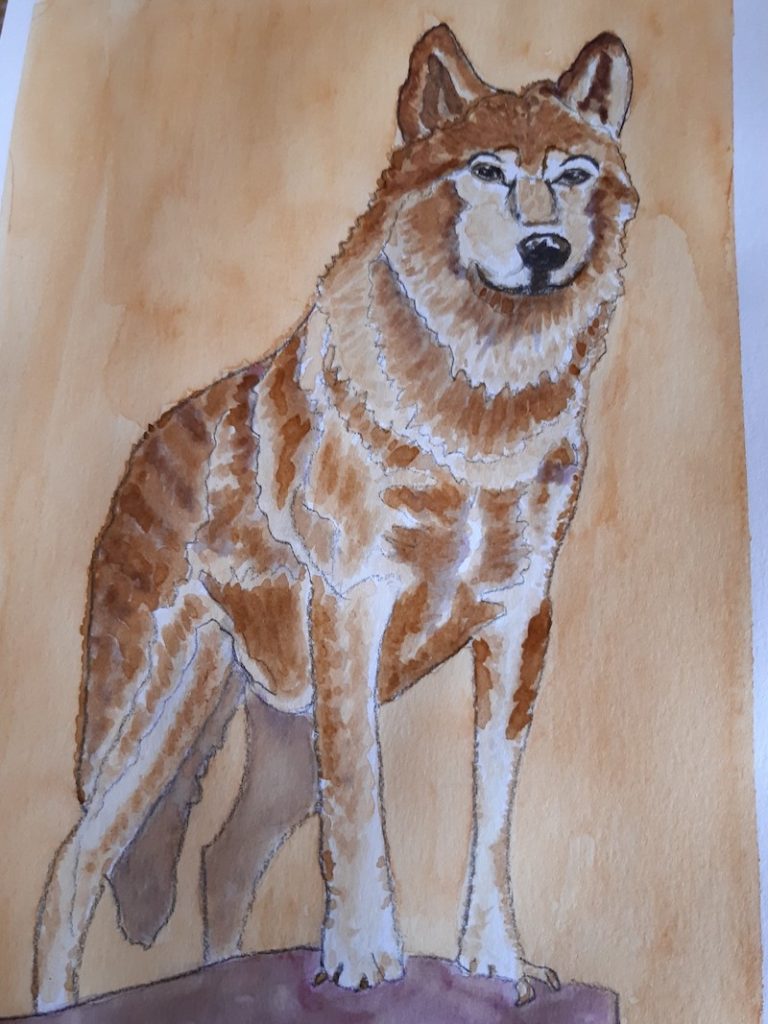
The technique when painting with tea is like when using watercolour. After initial painting, the work needs to be left to dry before being worked over. Obviously, the more times you work over the piece, the darker and stronger the colour becomes. With all the art activities we feel it’s important to introduce a medium or activity in the session that can be expanded on or developed in their own time should they wish.
Painting in this manner lends itself to slowing down and taking your time, have a cup of tea between layers! Once you slow down and make alongside your partner or other artist something different happens to the conversation, there is something shared; a mutual focus. After a making session there is a sense of coming out the other side a slightly different person, you can see the world differently after such focus. This doesn’t necessarily happen and that is also fine; the opportunity is there though and that is of great importance to me as an artist myself.
Pilot session 2: The Human Touch
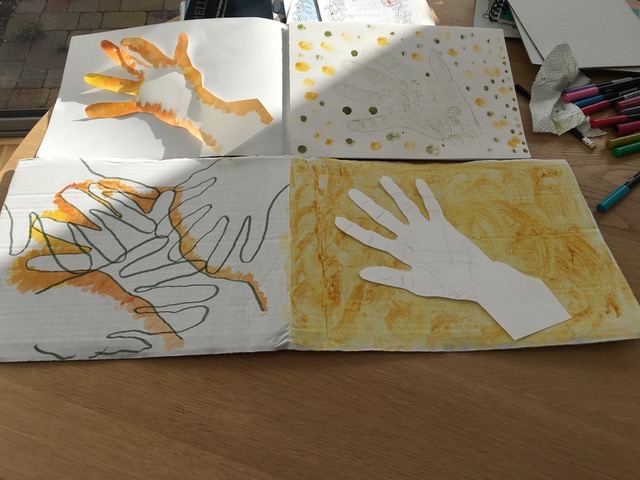
This exhibition showcases works of art related to touch.
‘Touch is our first sense, It develops in the womb as our brain first springs to life, even before ears and eyes have formed. The earliest traces of human creativity are the direct imprint of touch, grooves made by fingers or prints made by the whole hand. Through touch we make art, stake a claim to what we own and those we love, express our faith, our belief, our anger’.
We decided to use our own hands to draw around for the art making inspired by Human Touch. With four different relatively quick options to work on we hoped this would engage people and potentially be a good talking point at home. The outcomes were very pleasing ‘stand-alone’ pieces and we hoped people may want to display them.
In the art packs we sent out was more quality watercolour paper, other papers and some ink stamps to use with the fingers. We were using pencil, gouache paint and an old cloth. Previously having sent out brushes, pencils and paint meant we could draw on those materials without having to provide them again. The sessions now have a material ‘kit’ we can reliably draw on as we add new activities.
All the hand inspired pieces used our own left hand as a guide to draw around, except the first one where we drew round our right hand, to mirror our left hand which we needed to look at while drawing.
The first piece was a one line drawing of the palm of our hand made without taking the pencil off the paper. This is a lighthearted but challenging way into drawing with freedom, trying to focus on looking at your hand and not the paper. People are often reluctant to try this, but it has exciting outcomes, akin to mapping your palm. There often ends up being little resemblance to our hand but the lines can be beautiful!
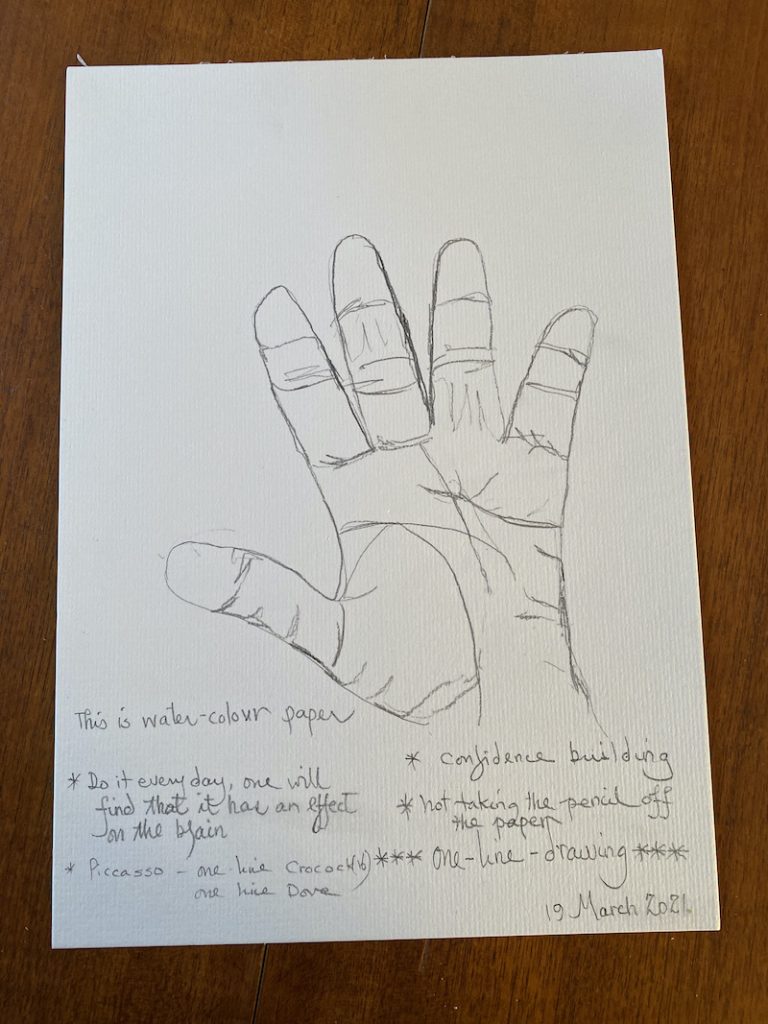
Using gouache paint the second piece required us to draw round our left hand and cut out the resulting hand shape. The cut-out hand was then laid down flat on paper and painted over in a ‘fanning’ motion resulting in a hand shape surrounded by paint, mirroring the magnificent pre-historic cave paintings of hands.
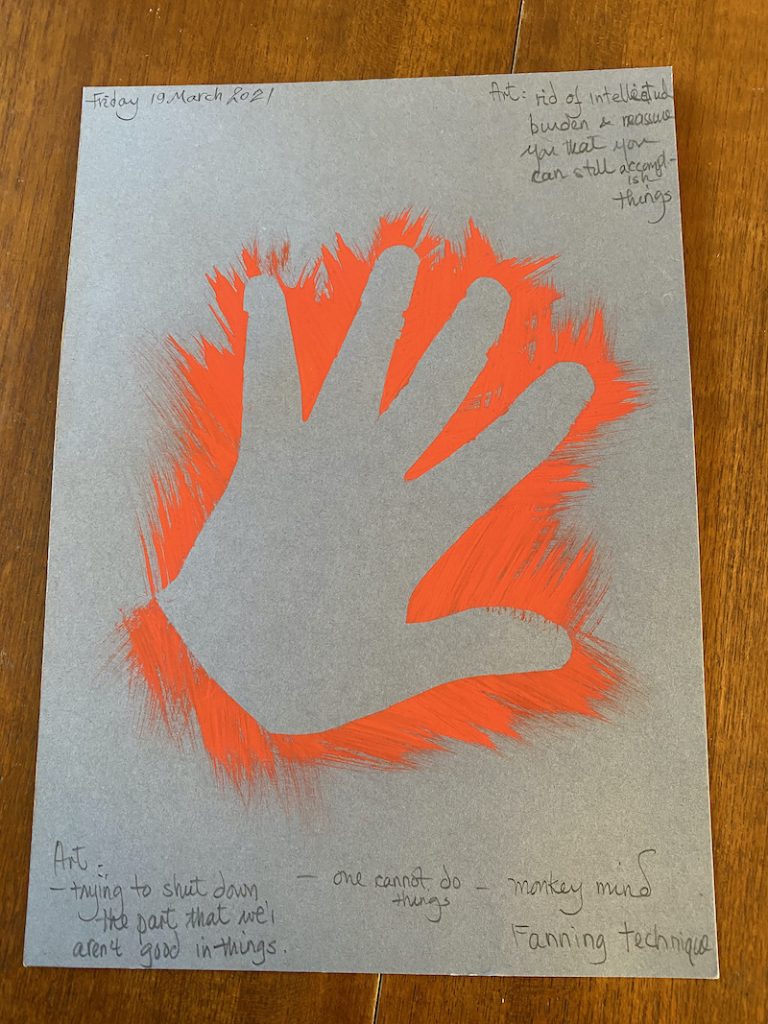
Handprint number three used paint and a crumpled up cloth. Using our left hand again to draw around we printed with wet paint using the damp crumpled up cloth to mop up the paint and then ‘print’ onto the hand. Obviously, the paint didn’t stay inside the lines, but this didn’t matter as once the paint dried, we painted round the hand in a contrasting colour. (see blog banner image)
The last piece, also using paint, or ink pads should they not wish to use paint, was made using the end of our finger to paint inside the drawn around hand. If the paint were thin enough you could see the fingerprint of the person on the hand which is a great way to ‘leave your mark’. With this one too you could let it dry and then go over with another colour, building up the image as much as you wished. To complete it we painted round the hand as before.
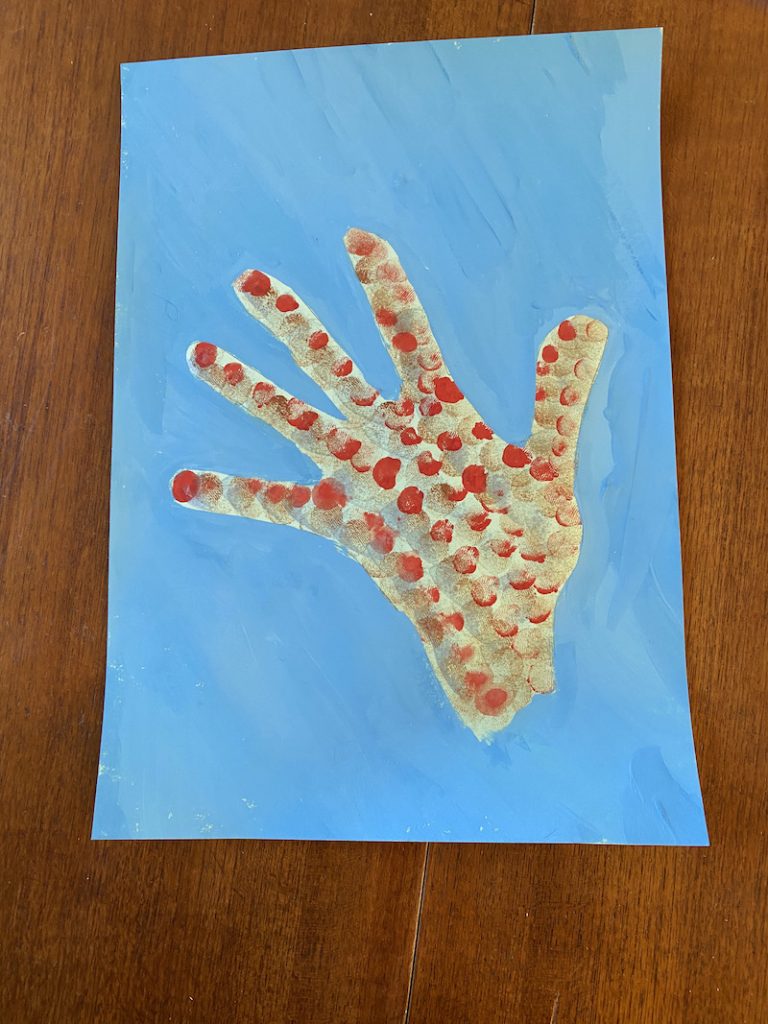
Final thoughts
The sessions ran from 1.45-3.00pm giving us plenty of time but not so long as to become too much. I decided to bring a small table into the studio and have my iPhone on an ‘arm’ on the other side, thereby I was able to talk to people and very easily change the angle of the camera to show the making in progress. This contrasted with other sessions and films where I would stand and talk and then move the camera into position for making. The way I did it for these last two sessions really worked as there was a relaxed intimacy possible allowing us all to chat informally and seamlessly go in and out of the making.
Both sessions were relaxed and hopefully rewarding for our participants. The work they have subsequently shared certainly bears this out!


